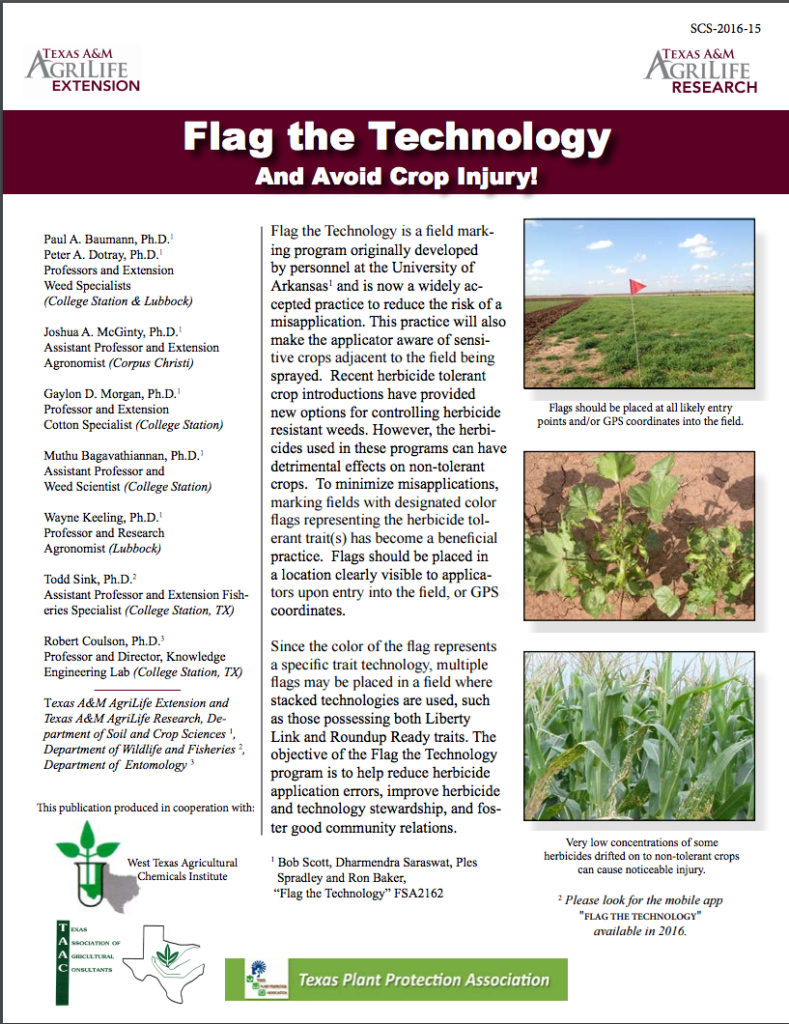Farm & Ranch
[AgriLife Today] ‘Flag the Technology’ helps farmers identify herbicide sensitive fields

By: Blair Fannin
Writer: Blair Fannin, 979-845-2259, [email protected]
COLLEGE STATION – The Texas A&M AgriLife Extension Service and the Texas Plant Protection Association have collaborated on a Flag the Technology program that identifies crop fields sensitive to certain herbicides.
With two new herbicide resistance technologies which will be widely used in cotton, corn and soybeans, program coordinators say it is critical farmers know which fields are safe for application of the new products and which are sensitive to them.
The program, which originated in Arkansas, is a system that helps farmers identify fields that are safe for application and those which must be avoided to prevent unintentional damage to the producers field or to adjacent crops. Farmers will place colored flags at entry points on fields, with each flag color representing a different kind of technology. This will make herbicide applicators aware which products are appropriate and safe to use on a specific field.
Texas Plant Protection Association chairman Ray Smith in College Station said during the association’s recent conference in Bryan the program and mobile app will “help enlighten our farmers on how to use the new technology. This app also emphasizes good recordkeeping.”
The mobile app can also be available to spray applicators who can check flag colors as they enter a field. The flag indicates which products they can use.
The following are flag colors and uses:
– White — Technology is tolerant to glyphosate herbicides.
– Green — Tolerant to glufosinate herbicide, Liberty.
– Yellow — Clearfield rice, sunflowers, wheat and canola which are tolerant to imidazolinone herbicides.
– Teal — Tolerant to both 2, 4-D and FOP (ACCase) herbicides, or Enlist technology. The white stripes indicate tolerance to glyphosate, Roundup. For Enlist cotton traits and soybean fields, a green flag should be added to denote tolerance to glufosinate herbicide (Liberty).
– Black and white checkered —Tolerant to both dicamba, Engina and Extendimax, and glyphosate, Roundup Ready Xtend.
– Red — Extreme caution required. Indicates conventional crops with no herbicide tolerant traits as well as sensitive production areas such as vegetables, vineyards, apiaries and organic production.
The new app builds on the field program developed by Bob Scott at the University of Arkansas, Smith said. Dr. Todd Sink, AgriLife Extension wildlife and fisheries specialist in College Station, developed the Flag the Technology app.
Users also have the option of meshing the app with Hit the Target, formerly known as Texas Crop Registry, a voluntary program that allows producers with sensitive crop areas to register specific fields, including non-GMO acres, orchards and others, said Dr. Bob Coulson, Texas A&M AgriLife Research entomologist.
“That information will be available to pesticide applicators,” Coulson said. “Individuals must register to use the system. Producers who register will specify field location and add the crop or sensitive nature of the area.”
Coulson said producers would need to calculate field dimensions. With that information logged in, Coulson said, the producer can go to the Flag the Technology program and select the color flag needed for the fields.
“The applicator will have a dashboard with the field profiles included to prevent off-target applications,” Coulson said. He added Hit the Target will soon transition to a new program, which can be accessed through a mobile device.
Sink said the Flag the Technology app is user friendly.
“It loads within five seconds,” he said. “The pesticide applicator is aware of where sensitive crops are located and can adjust flight plans to avoid those areas.”
The mobile app will be available free for iTunes and Google Play. A publication about the program is available for download at http://bit.ly/2j9Sce0 .
-30-
Find more stories, photos, videos and audio at http://today.agrilife.org
Farm & Ranch
Hazards of Backyard Poultry

By Barry Whitworth, DVM
Having backyard poultry is a popular agriculture enterprise. According to the United States Department of Agriculture, 0.8 percent of all households in the United States have chickens. People keep chickens for a variety of reasons with table eggs being one of the more common reasons.
Unfortunately, some of these poultry producers are not aware of the hazards that come with keeping poultry because many times they carry pathogens but appear healthy.
Chickens are carriers of several zoonotic diseases. These are diseases that can be passed from animals to humans. According to a recent survey in Pennsylvania, a majority of backyard poultry producers were aware of the dangers of avian influenza. However, this study also revealed that far fewer producers were aware of the risk of possible exposure to Salmonella and Campylobacter.
The lack of knowledge about the hazards of raising poultry likely contributes to the continued issues of Salmonella outbreaks associated with backyard poultry. In 2023, the Centers for Disease Control and Prevention reported 1,072 illnesses of Salmonella linked to backyard poultry, and 272 of those patients required hospitalization. Oklahoma reported 43 individuals with the disease.
To read more, pick up a copy of the April issue of NTFR magazine. To subscribe by mail, call 940-872-5922.
Farm & Ranch
Ag Elsewhere: Wyoming

By Tressa Lawrence
Babies are tucked away in every nook and cranny. Many ranchers across Wyoming have baby animals popping up all over this time of year.
Farm & Ranch
Ag Elsewhere: Montana

By Lindsey Monk
Another load of grain in to keep feeding the calves until the green grass can really start popping.
-

 Country Lifestyles1 year ago
Country Lifestyles1 year agoScott & Stacey Schumacher: A Growth Mindset
-

 Equine7 months ago
Equine7 months agoThe Will to Win
-

 Country Lifestyles7 years ago
Country Lifestyles7 years agoStyle Your Profile – What your style cowboy hat says about you and new trends in 2017
-

 Country Lifestyles4 years ago
Country Lifestyles4 years agoAmber Crawford, Breakaway Roper
-

 HOME7 years ago
HOME7 years agoGrazing North Texas – Wilman Lovegrass
-

 Country Lifestyles7 years ago
Country Lifestyles7 years agoDecember 2016 Profile, Rusty Riddle – The Riddle Way
-

 Country Lifestyles8 years ago
Country Lifestyles8 years agoJune 2016 Profile – The man behind the mic: Bob Tallman
-

 Outdoor9 years ago
Outdoor9 years agoButtercup or Primrose?







